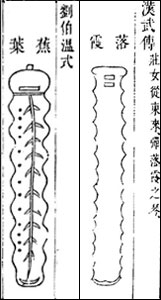|
T of C
Home |
My Work |
Hand- books |
Qin as Object |
Qin in Art |
Poetry / Song |
Hear, Watch |
Play Qin |
Analysis | History |
Ideo- logy |
Miscel- lanea |
More Info |
Personal | email me search me |
| Taiyin Daquanji ToC / More depictions / Previous - Next | 首頁 |
|
Taiyin Daquanji
1
Folio 2: Qin Styles 2 (Part 1; QQJC I/52b-61b) |
太音大全集 卷二﹕琴式,甲 |
Explanation:3 The various editions of this handbook differ somewhat in the content of their collections of qin styles;4 and at least 10 later handbooks also have similar qin illustrations, the number of instruments depicted varying from as few as 13 to as many as 59.5 Some also discuss qins for which they have no images, as in Part 2 of the present handbook. Taiyin Daquanji, here at the beginning of Folio 2, has images of 38 qins; these are here lined up to the right of the corresponding translations. At least one of the later handbooks adds an extra illustration of a related person with each qin image: Fengxuan Xuanpin (1539), which has the same 38 qins as here, in almost the same order, and so each one is linked here next to each title.6 In addition there is at least one set of independent illustrations showing a person seated on the ground with the qin either on their lap or on the ground next to them.7
|
1. Fu Xi
1-1
( ⤑ 1539 #1
[中文])
Fu Xi saw phoenixes collecting on a tong tree1-2 and thereupon, imitating this shape and giving it a vertical height (length) of 3 chi, 6 cun, 6 fen, made this into a qin.1-3 He regulated the assemblage so it produced the six notes and six tones,1-4 getting the numbers from the 366-day year (ji). He obtained sacred cocoons to make the strings.1-5 The music repaired the body, regulated the disposition, and restored the inner soul. Qin-makers thereupon copied this style. Han (Ying's) Outer Commentary on the (Classic of) Poetry1-8 says, Fu Xi's qin was 7 chi 2 cun in length, reflecting the 72 five-day weeks.1-9 It had 20-strings.1-10 Record of the Yellow Emperor1-13 (says) Fu Xi set out a qin; Nü Wa accompanied him.1-14 [Yin shi:]1-15 "Wa" sounds like "vomit". Nü Wa was Fu Xi's younger sister. "Accompany" is said with a departing tone. 1-2
桐 tong is the name of various types of trees; the best wood for qin is said to be 梧桐 wutong (sterculia platanifolia), though more detailed claims say that this relatively light wood is only for the top of the qin; the bottom board should be made from the heavier 梓木 zimu (catalpa ovata). See
Qin body.
1-4
The numbers here, 3 chi (feet), 6 cun (inches), 6 fen (10ths of inches), clearly refer to the 366 days for a year. Modern qins tend to be about 4 feet long.
1-5
6 律 lü (regulations, notes) and 6 呂 lü (tubes, tones)
1-6
This feng (風, meaning "wind") has the same pronunciation as 鳳 the feng meaning "phoenix".
1-7
Where does this order come from?
1-8
韓詩外傳 Han Shi Waizhuan; see Yin shi. For 韓嬰 Han Ying, 2nd c. BC, see 44126.377c and Giles: noted scholar said to have written a Neizhuan (Inner Commentary; not extant) as well as the Waizhuan, for which is he well known.
1-9
候 hou: a period of five days. See Yin shi.
1-10
The Zhu volume adds the character 琴 "qin" after
"20-strings".
Elsewhere the instrument is called a 離 li and said to have had 27 strings.
1-12
正月東風鮮凍至十二月水澤腹堅 . 東風 14827.317xxx; 鮮凍 47090.xxx; 水澤 17458.776 "water and marsh"; 腹堅 30385.32 "deep water about to freeze" (the latter two both quote 禮記月令 Li Ji Yue Ling.
1-13
Record of the Yellow Emperor : 軒轅記 Xuan Yuan Ji. Is this the 軒轅皇帝傳 of 39039.87?; Xuan Yuan was another name of the Yellow Emperor, after the name of his birthplace.
1-14
軒轅記:「伏羲置琴,女媧和之」. This quote is slightly different under
Nü Wa. Also, here in the text the 媧 "Wa" of 女媧 Nü Wa (6170.205) is written 蝸, pronounced gua or wo: i.e., it uses 虫 the insect/reptile radical instead of the woman radical. The Yin shi writes 女媧 but gives no comment on the discrepancy, saying only that the pronunciation is like 哇 wa ("vomit"). 6170 女 nü does not include a 女蝸 Nü Gua, and 34114 蝸 Gua makes no mention of either 女蝸 Nü Gua or 女媧 Nü Wa. However, illustrations of Nü Wa show her with a human head but the body of a snake.
|
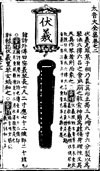
|
2. Shen Nong 2-1 ( ⤑ 1539 #2 ) Zhuge Liang 2-2 said that Shen Nong's qin was 3 chi, 6 cun, 3 fen long. This was so that it could resonate with the "three brightnesses" The Forest of Words2-3 said, Shen Nong made a five-string qin. Its length was 3 chi, 6 cun. Huan Tan's Xin Lun says, Shen Nong cut tong wood to make a qin, using silk for the strings, in order to communicate the righteousness of the gods (and) bring together the harmony of heaven and earth. (The book) also says, a qin with seven strings was sufficient to communicate with all things and examine what is right. Notes for Image 2 2-1 The first of the five legendary emperors; Giles says he lived 2852-2737. The Zhu volume has this commentary but not the image, writing 襲伏之制 Xi Fu zhi zhi (35533.xxx? see also the next image). (Return) 2-2
The Zhu volume adds: 琴經 "in Qin Jing"
2-3
字林 Zi Lin (7083.16 name of a book, in 3 folios, by 呂忱 Lü Chen [5th c. CE?; no bio.). The Yuan volume has 字林云, but the Zhu volume correctly has 字林名.
|

|
3. Di Zhong (Transmitting Affection) 3-1 ( ⤑ 1539 #3 ) The Yellow Emperor, emulating the style of Fu (Fu Xi), ordered this qin and called it Di Zhong. The Former Han Dynasty's Wang Bao,3-2 in Praise of Famous Men, said that Bo Ya played it. The Fu Yuan of the Jin dynasty transmitted a Di Zhong that had belonged to (King) Wei of Qi (see Zou Jizi).3-3 Formerly, the Yellow Emperor planned to call a meeting of spirits in the Eastern Mountains. He rode five elephant carts, joined dragons and bifang birds together, and also detained the Chi You, to be placed in front of him. Feng Bo (a spirit) came in and swept up, the Rain Master (a spirit) washed the road, phoenixes flying in accompaniment. Arriving in the mountains he assembled the gods and demons, and used the Di Zhong qin to play the tune Qingjue.3-4 Selected Compilation of Liang Emperor Yuan says, Old qins include one (called) Qingjue. It was the Yellow Emperor's qin.3-5 Notes for Image 3 3-1 遞鍾 Di Zhong (Transmit Affection); 39931.32: name of a qin, also called Proclaim Affection (號鍾 Hao Zhong, see #10 below); 33530.70 also says it is the same as Hao Zhong; quotes Han Shu about Boya playing this qin. The Zhu volume has the commentary but no image, writing in its place 黃帝襲伏之制而命曰號鐘 (? see also the previous image.) [TKW54:] The Zhu volume for 遞鍾 has 遞鐘 (bell); it has only the explanation and not the illustration
3-2 王褒 Wang Bao (1st C. BCE; ICTCL); 賢臣頌 In Praise of Famous Men. (Return) 3-3 晉傅元 Fu Yuan (970.xxx) of the Jin dynasty; 齊威(王) (King) Wei of Qi.(Return) 3-4 神靈 (see 43306) spirits; 畢方 Bifang; 蚩尤 Chiyou; 風伯 Fengbo; 雨師 Rainmaster (Return) 3-5 15135.102 粱元帝 Liang Yuandi (ruled 552-4) was 3267.531 蕭繹 Xiao Yi (508-554). These two entries say he wrote a lot and had a large library, which he burned when he was killed, but make no mention of his Selected Compilation (纂要 Zuan Yao), which was perhaps done by a later person based on his books or his library. (Return) |
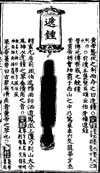
|
4. Yu Shun 4-1 ( ⤑ 1539 #4 ) Yu Shun's qin was 3 chi, 8 cun, 2 fen long. It used old jade chi compared to xuansheng4-2 that were two chi 6 cun; near the mountain, 2 cun; dragon's lips, 2 cun. All this regulated the appearances of yin and yang as well as lü and lü.4-3 Qing Ying (Qin Qing Ying?) by Yang Xiong says, Shun played a five-string qin and all under heaven was controlled (see melody titles). Wen Wang added two strings in order to the harmonize the righteousness of rulers and their officials. 4-2 用古玉尺比宣聲 . 7276.225 宣聲 says only that it was a nickname for 薛夏 Xue Xia of the 3 Kingdoms period, an unlikely connection. See also Zhongni, below. (Return) |
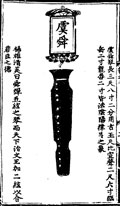
|
5. Ling Guan (Music Master) 5-1 ( ⤑ 1539 #5 ) Yu Sui was a Music Master.5-2 He regulated the great principles, and pared a qin down to 3 chi 6 cun, with a protruding (? 生 ) neck and forehead style. It had a large resonance. He gave it to Wen Wang. During the reign of (Wen Wang's grandson) Cheng Wang, (Wen Wang's son Zhou Gong) was slandered by two brothers, so (Yu Sui) wrote Zhou Gong Melody to offer as a present. Tears flowed ceaselessly, in heaven, there was thunder and lightning, causing wind to pull up grain and uproot trees; the people were very alarmed. The king (then) opened the gold (chains) binding (him), and again started utilizing Zhou Gong. Notes for Image 5 5-1 伶官 Ling Guan (Return) 5-2 虞隨 Yu Sui's biography in (Qinshi Bu, #12) tells essentially the same story, giving 曆代琴式注 Notes on historical qin styles as its reference. This story is also used in Xilutang Qintong (1525) to introduce the melody Feng Lei. (Return) |

|
6. Zhongni (Confucian) 6-1 ( ⤑ 1539 #6 ) The qin of Confucius was 3 chi, 6 cun, 4 fen long. This uses Zhou chi. Same as Xuan Sheng, 3 chi, 6 cun, 4 fen is exactly the number (to the?) dragon's lips.6-2 6-2 宣聲 Xuan Sheng and 龍唇 dragon's lips are both mentioned in Yu Shun above. (Return) |

|
7. Yunhe (Harmonious Clouds) 7-1 and 7-2 ( ⤑ 1539 #7 ) Play a qin from Yunhe (Harmonious Clouds) when a winter day arrives, on a round mound above solid ground. Play a qin from Kongsang7-3 (Empty Mulberry) when a summer day arrives, on a square mound above marshy ground. Play a qin from Longmen7-4 (Dragon Gate) in a temple. Wood from Yunhe blends with heaven. Wood from Kongsang is attuned to the earth. (Material from) Longmen harmonizes the demons and deities. This is why (these are good for making qins). Xiao You of the Tang dynasty had the experience of playing these qins. 7-2 [TKW56:] The qin illustration of Harmonious Clouds was not very clear in the Yuan volume I based this on, and the Zhu volume was not clear either. Now based on (the illustration in) Fengxuan Xuanpin (1539) I have restored the 12 white points (marking the strange position of the studs) on the lower half of the qin; the materials are not mistaken. (The image here is also restored accordingly). (Return) 7-3 Kongsang 空桑 25994.163: Place name associated with Shandong and Confucius, but also elsewhere. Also the name of a 瑟 se zither and a mountain good for making both qin and se. 周禮春官大司樂 Zhou Li, Chun Guan, Dasi Yue is again quoted, but no attempt is made to identify the location) (Return) 7-4 Longmen 龍門 49812.101: Gives many meanings and many place names but does not identify which one has good wood for qins. 龍門桃浪引 Longmen Taolang Yin was the name of a qin melody. ([TKW57:] Fengxuan Xuanpin adds the plausible "material from"; the Zhu volume omits "相 harmonizes".) (Return) |

|
8. Shi Xiang 8-1 ( ⤑ 1539 #9 ) Shi Xiang of Wei made (this qin). The shoulders and neck were straight and deep. It was beginning to have disorderly crack patterns, silk-like, not really going into the lacquer.8-2 (Shi Xiang) used this illustrious qin to connect the 72 modes and write 890 tunes. He was Confucius' teacher. Notes for Image 8 8-1 Shi Xiang 師襄 9129.189 Confucius' qin teacher; from 衛 Wei; see Van Gulik, p.81, etc. (Return) 8-2 端有亂紋,如絲,漆之不入。 (漆之不如, i.e., the best lacquer? See also duanwen.) (Return) |

|
9. Yue Qin (Moonshaped Qin) 9-1 ( ⤑ 1539 #8 ) Shi Kuang of Jin9-2 made this with a center like the moon. Its shape described a landscape.
Notes for Image 9
9-2 Shi Kuang 師曠 9129.198/9 of 晉 Jin. Giles: blind, but using musical skills to charm supernatural beings. (Return) |
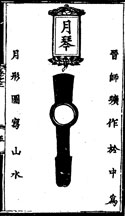
|
10. Hao Zhong (Sounding Bell) 10-1 ( ⤑ 1539 #10 ) This is what Chu poetry10-2 mentions as the Hao Zhong that is the broken qin of Boya.10-3 33525.64 號鍾 Hao Zhong (Proclaim Affection) is a longer entry. It also begins "琴名 qin name", without adding that it is the same as 號鐘 (see above); perhaps this means it was the original name, but it is clear from the context that the intention is the same. It then quotes more sources:
See also Di Zhong above -- that seems to refer to a different qin. See also the Hao Zhong in the list of qins without illustrations -- one of four mentioned in the Zuan Yao of Liang Yuandi. It is also associated with 齊宣公 Duke Xuan of Qi. This qin is also mentioned in Qin Jian.(Return) 10-2 楚詞 Chu Ci, but it is in what is generally considered an addition to the original Chu Ci 楚辭,劉向,九歎愋愍命 Liu Xiang's Jiu Tan (See Hawke, Songs of the South, Nine Laments [pp. 280 - 306], Grieved by this Fate [#7, see p. 296, line 31].) (Return) 10-3 After Ziqi dies, Boya breaks his qin and never plays again: in life you are lucky to have one person who understands your music. That one person having just died, why play again? (Return) |

|
11. Ziqi 11-1 ( ⤑ 1539 #11 ) Made by Zhong Ziqi. The neck was straight and deep. It was beginning to have disorderly crack patterns, silk-like, not really going into the lacquer.11-2 The neck was made with the shape of a half-moon. As a youth with Boya he was a colleague together under Mr. Cheng Lian. He received 120 tunes. Ziqi helped create 508 melodies, with 28 modes. His family was poor. He made little business, taking a qin with him to the market. Notes for Image 11 11-1 Ziqi 子期 : see Zhong Ziqi (Return) 11-2 This is verbatim the same as a passage describing Shi Xiang. (Return) |
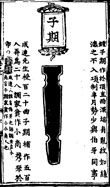
|
12. Liezi 12-1 ( ⤑ 1539 #12 ) Liezi made it. The area between the two necks had the appearance of a lofty knife.12-2 He had previously traveled to Mt. Tai, where he saw lightning strike down a tong tree, from which he made a qin (compare Cai Yong's scorched tail qin). It had a large resonance.12-3 He lived at Zhengpu12-4 for 40 years (but) no one recognized him. He wrote the two songs Xiangling12-5 and Kuyu.12-6 He devised 72 small modal compositions12-7 (and) made 120 types of miscellaneous compositions.12-8 Notes for Image 12 12-1 Liezi 列子 , was also called 列禦寇 Lie Yukou. According to Giles, Liezi was an allegorical person of the Warring States period, created by Zhuangzi. See also A.C. Graham's introduction to his translation, The Book of Lieh-Tzû, which he says was probably written about 300 AD. (Return) 12-2 [TKW38:] "Lofty strength'" (in QFTGYY) is "lofty knife" (here) in the Yuan volume. The Yuan volume Liezi qin illustration is in QFTGYY, p. 50. (Return) 12-3 [TKW39:] QFTGYY correctly has 有大聲 (here it is 大有聲). The Zhu volume has 有火聲 "had the sound of fire", a mistake caused by confusion with the Pi Li qin (#38). (Return) 12-4 Zhengpu 鄭圃 40513.281 mentions Liezi but doesn't say where Zhengpu is. (Return) 12-5 Xiangling 襄陵 35354.49; name of an old place in north China; qin melody (see 襄陵 Xiangling Cao) also attributed to 大禹 Emperor Yu. Only Xilutang Qinpu (1525; see #60) has tablature for a piece of this name. (Return) 12-6 Ku Yu 枯魚 14950.58; dried fish -- they have no smell, representing man with nature; reference given from 古樂府 Old Yuefu. Old lists include a melody called Ku Yu Yin. (Return) 12-7 小調 xiao diao: modal compositions? (Return) 12-8 [TKW40:] ya nong 雅弄 "Elegant compositions" in QFTGYY (instead of za nong 雜弄 miscellaneous composition, as here); the Zhu volume has "160 compositions" instead of 120. (Return) 12-9 The Yin shi is not in QFTGYY. 襄陵 Xiangling and 枯魚 Ku Yu were apparently 上聲歌 (17.768), ancient Yuefu songs from 吳 Wu. (Return) |

|
13. Shuang Yue (Double Moon) 13-1 ( ⤑ 1539 #13 ) Made by Rong Qiqi, at the waist it had two small moon shapes. It had a deep, solid resonance.13-2
Notes for Image 13
13-2 Rong Qiqi 榮啟期 15559.74/5: his "triple happiness" at the age of 90, when he met Confucius, gained him the latter's respect. (Return) |

|
14. Yan Rong (Hidden Appearance) 14-1 ( ⤑ 1539 #14 ) Min (Sun) made (this qin) using the Confucian style in the two shoulders. It had the significance of Hidden Appearance (since Min Sun wanted to retire from office). Confucius introduced him to a high position, (but) then (Min Sun) wrote (melodies called) Li Dong (Verdant Grotto), Yun Chao (Cloud Palace) and Tian He (Heavenly Crane) to present to Confucius. Confucius realized that Min Sun didn't want to hold office, (and) later Min Sun did indeed return home. Notes for Image 14 14-1 Hidden Appearance (Yan Rong 掩容 12538.xxx). QFTGYY has this image. The Zhu volume also has it, with the same commentary, but calls the image Shaking Valley (Zhen Gu 振谷 12407.xxx), apparently a mistake. (Return) 14-2 QFTGYY does not have this Yin Shi; the text also has a few small differences. (Return) |

|
15. Feng Su (Phoenix Crop) 15-1 ( ⤑ 1539 #15 ) Shi Cao of Wei15-2 made this one. On its forehead were attached two round cicadas. (Shi Cao) wrote 39 overtures, (and) fixed 67 melodies. He used the qin when paying a visit to Ling Gong (the Duke of Wei). The duke thus knew he was capable and ordered him to teach but he did not succeed. Later he returned to Phoenix Mountain. Every time he played the qin immortals would appear. Another story is that he was ordered to teach female attendants, but he beat them. The duke became very angry and had Shi Cao whipped 300 (lashes). Notes for Image 15 15-1 Feng Su 鳳嗉 47631.xxx. The crop is by the throat/neck, but "phoenix crop" may also refer to the forehead of a qin. (Return) 15-2 The biography of Shi Cao discusses him together with one 師開 Shi Kai. (Return) |

|
16. Gezi 16-1 ( ⤑ 1539 #16 ) Made by Gezi, the forehead is covered (fou) with the appearance of two moons. It has the sound of wind and rain, both clear and muddy. |
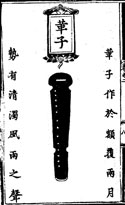
|
17. Long Yao (Dragon's Waist) 17-1 ( ⤑ 1539 #17 ) Xie Juanzi of Lu17-2 made this one. The waist area he made the shape of half moons. With three strings17-3 it had the sound of seven strings. Once when traveling through the area of the Yangzi and Huai rivers, playing his qin beside the beautiful scenery, he met a woman who was carrying a small lüqi style qin. What (she?) played had a sound that was not common.17-4 Juanzi welcomed her. She said, I am a woman of Beiling. In this way he learned Qingjiang Yin.17-5 Notes for Image 17 17-1 Long Yao 龍腰 49812.498 has basically the same information (including mention of three strings), quoting Ming publication Qinjian Tushi. (Return) 17-2 魯謝涓子 Xie Juanzi of Lu 36661.xxx, but see Qinshi Bu #24. Most of the information here is also related there. (Return) 17-3 Three strings (probably not "three of its strings"). This page also has two other three string qin, #23 Ya E and #27 Xiang Quan. (Return) 17-4 [TKW43:] The Yuan and Zhu volumes say "very common sounds", which is possible. Punctuation should be added. (Return) 17-5 Qingjiang Yin 清江引 As a qin melody, this title survives only in Chongxiu Zhenchuan Qinpu (#11). (Return) |

|
18. Long Shou (Dragon's Head) 18-1 ( ⤑ 1539 #18 ) Made by Gang, King of Yan;18-2 in appearance a point protruded from between (each of) the two foreheads (and) it was 2.5 cun broad. It had a clear, solid and long-lasting sound. 18-2 燕王剛 Gang, King of Yan (19876.21ffxxx): this apparently refers to 姬剛 Ji Gang, said to have been a 後 "hou" (descendent?) of 周召公 Zhou Zhaogong. The short Ji Gang entry says he made the qin, giving basically the same information as here. The proper name of Zhou Zhaogong was 6370.71 姬奭 Ji Shi; he was a brother of 周公 Zhou Gong. Zhaogong was 封北燕 was enfeoffed in North Yan. Since his proper name was Ji, perhaps he was Marquis (侯 hou), but all of the texts have 後姬 hou ji, without comment. (Return) |

|
19. Feng She (Phoenix Tongue) 19-1 ( ⤑ 1539 #19 ) It is not known who made this qin (sic).19-2 Qin Jiao of Wei19-3 made it. The phoenix tongue had protrusions that slanted 3 cun. Below is a pointed shape. If well-practiced in the zhi mode, whenever you sit to play in the snow, suddenly the weather will become more temperate. Chen Yu19-4 was ordered to play the qin in the hottest part of summer. He played "southern sounds" and suddenly from the east clouds arose. By the time the piece finished, the snow was three chi deep. 19-2 QFTGYY does not have this first sentence, and in light of the next sentence presumably it is a misprint. (Return) 19-3 Qin Jue 秦玨 25578.xxx. Qinshi Bu (#27) and Guangbowu Zhi have same information as here. (Return) |

|
20. Long Han (Dragon Jaws) 20-1 ( ⤑ 1539 #20 ) Made by He Yun of Lu.20-2 At the neck and shoulders were slanting protrusions of 1 cun, 2 fen (and) five strings. (He Yun) once took advantage of a calm evening by the Huai and Si rivers20-3 to play. Suddenly three men appeared, saying, "We are three worthies20-4 from the Shang dynasty who were buried in this area. We have heard how beautiful the sound of your qin is, but you don't quite understand the classical qin style." So they taught him two melodies, Jiao Yue (Bright White Moon) and Feng Lei (Wind and Thunder).20-5 Notes for Image 20 20-1 Long Han 龍頷 49812.634xxx; the Qinshi Bu biography of He Yun and Guangbowu Zhi have much same information as here, but they call the qin itself Dragon's Forehead (龍額 Long E). (Return) 20-4 三賢 San Xian. 10.1649 三賢十聖 is Buddhist; Confucius wrote of three Shang ancients (王子 , 比子 , 箕子 , 微子???). (Return) 20-5 皎月 Jiao Yue 23236.2: no music connection mentioned, and this title does not seem to appear on any old lists. 風雷 Feng Lei is presumably the same title as that of the 1525 melody of that title, later usually called 風雷引 Fenglei Yin; it is sometimes attributed to He Yun. (Return) |
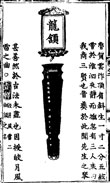
|
21. Fu Bei (Overturned Cup) 21-1 ( ⤑ 1539 #21 ) Made by Shi Jing of Wei.21-2 On the two shoulders were broad fins 1 chi 2 cun wide. It had 5 strings.
Notes for Image 21
21-2 魏師經 Shi Jing of Wei 9129.168xxx was the honest and brave music master of Marquis Wen of Wei. (Return) |
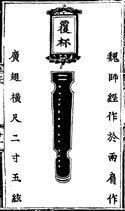
|
22. Feng Shi (Phoenix Aspect) 22-1 ( ⤑ 1539 #22 ) Yang Ying of Wei22-2 made this one. At the middle of the waist and shoulder were protruding points. It was two cun broad (and) had a thunderous sound.
Notes for Image 22
22-2
Yang Ying 楊英 15489.391xxx: see Dongzhong Chun (Spring in a Cave)?
|
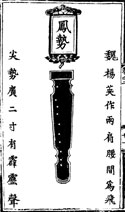
|
23. Ya E (Cross-shaped Forehead) 23-1 ( ⤑ 1539 #23 ) Hu Yan of Zhao23-2 made this. In the middle of the two foreheads there are secondary foreheads that protruded 3 cun. It has a large sound. Its three strings23-3 could provide all the tones (lülü).
Notes for Image 23
23-2 趙胡言 Hu Yan of Zhao: 30073.xxx (Zhao Huyan 38015.xxx); known for three-stringed qin, but see Gu Yuan Xiao Yue. (Return) 23-3 三絃備呂律 Not "three of its strings": see three string qin as well as #17 Long Yao and #27 Xiang Quan. (Return) |

|
24. Shen Hui (Radiant Spirit) 24-1 ( ⤑ 1539 #24 ) Made by Chen Zhang of Qin.24-2 Below the waist were four moons on the sides. It beautifully played yu (mode) melodies. During the summer period playing this qin was welcomed.; there would be natural light breezes.
Notes for Image 24
24-2 Chen Zhang of Qin 秦陳章 42618.718xxx, but see Qinshi Bu, #28, which has the same description, citing Guangbowu Zhi. (Return) |

|
25. Qin Qin (Qin of Qin) 25-1 ( ⤑ 1539 #25 ) Made by Qin Shihuang 25-2 (the founder of the Qin dynasty), its string pegs, mountain and tail were all black; the studs were made of green jade. This is what brought it honor. 25-2 In the Qinshi Bu entry on 秦始皇 Qin Shi Huang the character 絃 xian in the first line has been omitted or changed to 琴 qin, while 徽 hui in the second line is changed to 之 zhi, so that there the sentence reads "the pegs, mountain and tail all were made from black green jade." (Return) |
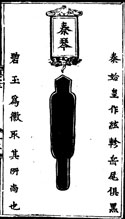
|
26. Long Sai (Dragon Cheeks) 26-1 ( ⤑ 1539 #26 ) Made by Li Si,26-2 (Prime Minister) of Qin. Above the phoenix tongue was added an area 3 cun round. Between the two foreheads it received a breadth of 3.5 cun (the words?) "Wily Rabbit" (Jiao Tu26-3). 26-2
Li Si 李斯: It was he who suggested burning the books -- see Giles. 14819.1243 has nothing on music.
26-3 jiao tu 狡兔 20829.12 mentions by tradition the rabbit is crafty, but has nothing about music or qins. Shi Ji #87 says that just before Li Si was executed he said to his son, "I wish we could again go out...and hunt the wily rabbits." (Return) |

|
27. Xiang Quan (Melodious Spring) 27-1 ( ⤑ 1539 #27 ) Zhang Dao, 27-2 the Han court's qin guest, made it. It had three strings. The double waist had a repeated moon shape. He enjoyed creating (melodies on the theme of) Flowing Streams, and often playing the qin by a riverbank. Thus he wrote The Fish are Jumping (Yu Yue) and Icy Pond (Bing Pan)(such? plus? as?) 20 melodies.27-3 Notes for Image 27 27-1 響泉 Xiang Quan (Melodious Spring) 44291.21 mentions a qin of this name belonging to 李勉 Li Mian. This is apparently a different qin, discussed in the section on qins with no images. Li Mian was a famous Tang statesman, literatus and qin player (ca. 800 AD); he particularly loved this qin and another called Yun Sheng (韻聲). [TKW61:] The Zhu volume is missing the qin illustration and explanation for (both) Xiang Quan qins; Fengxuan Xuanpin (1539) has (this, connecting it to Zhang Dao: see QQJC II/37) 27-2 張道 Zhang Dao (10026.xxx; Bio/xxx) (Return) 27-3 魚躍 Yu Yue(47030.xxx) and 冰泮 Bing Pan (1648.40) could also be one title, Fish Frisking in the Icy Pond (魚躍冰泮 Yu Yue Bing Pan), but the Yin shi says it is two. (Return) |

|
28. Lu Qi (Green Dappled Silk) 28-1 ( ⤑ 1539 #28 ) The Han dynasty's Sima Xiangru of Sichuan prefecture had a qin named Lu Qi.28-2
Notes for Image 28
28-2 QFTGYY has the same information as here (see more with its illustration); the Zhu volume says only "Sima Xiangru's qin." The qin illustrations in Fengxuan Xuanpin show this qin being played by Sima Xiangru while Wenjun listens from the next room. (Return) |

|
29. Jiao Wei (Scorched Tail) 29-1 ( ⤑ 1539 #29 ) As a man of Wu (Jiangsu) was using some tong wood for cooking, Cai Yong, from the sound of the fire burning the wood, knew that the wood had good sound properties (compare the story of Liezi making a qin from wood struck by lightning). So he asked if he could cut it to make a qin. He called it Scorched Tail.29-2 Notes for Image 29 29-1 Scorched Tail (also called Burnt Tail) Jiao Wei 焦尾 19585.33 & 35: say it is a qin name associated with Cai Yong, and categorize it along with three other famous qins, Hao Zhong of Duke Xuan of Qi, Rao Liang of King Zhuang of Chu and Lu Qi of Sima Xiangru. Scorched Tail Qin is also mentioned in later stories, such as that of Wang Zhongxiong. (Return) 29-2 Some accounts add that he gave it this name because the indications of burning could still be seen at the lower end of the qin. And the fame of this instrument led the lower end of the qin to be called the jiao wei. On the other hand, the reference could be not to the tail but to the wood itself, as in the term "焦桐 jiao tong": scorched paulonia (example). (Return) |

|
30. Ling Ji (Spiritual Power) 30-1 ( ⤑ 1539 #30 ) Liang Man30-2 made it. At each of the sides of the double forehead it protruded 2 cun. At the side of the waist there was a high outline. The shape gave it a resonant sound. When it was played flocks of birds would all collect. It has played such melodies as Ping Ling.30-3 Notes for Image 30 30-1 Ling Ji 靈機 43483.267xxx (Return) 30-2 Liang Luan 梁鑾; also Liang Man 梁蠻 15135.xxx; [TKW47:] The Zhu volume says 梁灣 Liang Wan. (See also Liang Hong, with his connection to Pingling.) (Return) 30-3 Pingling is also a place name; old lists include a 平陵道 Pingling Dao by 梁彎 Liang Wan. (Return) |
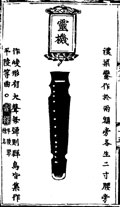
|
31. Si Feng (Four Peaks) 31-1 ( ⤑ 1539 #31 ) Made by Maming Sheng of Han,31-2 it has four peaks added to the shoulders. There was only one string (compare #37 below), but the sound was clear and refined. 31-2 Maming Sheng 馬明生 45550.xxx but see Qin Shi, #63 (Return) |

|
32. Ju Yun (Gathering Clouds) 32-1 ( ⤑ 1539 #32 ) Made by the Yellow Dragon Han teacher Luo Yue.32-2 The forehead was connected by a curve. Customarily bent facing the shoulders. The studs were adorned with jade and gold. The strings were vermilion colored. The pegs were of coral. (Someone) used a Dragon Beard and Phoenix Feathers for a qin pocket. It had the sound of a dragon singing and a tiger roaring. It determined Ju'an Li (and) Qingfeng Yin.32-3 Notes for Image 32 32-1 Ju Yun 聚雲 29751.59; no musical reference or other apparent connection. In fact, the total lack of references for anything in this illustration (and also the next several, perhaps to #36) suggests that sometimes the compilers were simply copying things of which they had no knowledge. (Return) 32-2 羅越黃龍漢師 29024.xxx/8/1051xxx; 48904.1126xxx; (Return) 32-3
制拘安離清風吟曲
Ju'an Li 12249.xxx;
Qingfeng Yin 18003.275xxx;
|

|
33. Chan Yi (Cicada Wings) 33-1 ( ⤑ 1539 #33 ) Made by Song Mengzhi of Han.33-2 At the tail a pair of (facing?) pointed cicada (wings?) were fastened. The sound of the strings was like the wind and rain (xiao san mournful wind sound dispersing).
Notes for Image 33
|

|
34. Yun Quan (Cloud Spring) 34-1 ( ⤑ 1539 #34 ) Made by Liu An of Jin.34-2 The sides of the neck were in the style of half moons. Meeting a female ghost, it taught him two melodies, Jiangnan Chun (Spring South of the Yangzi River)34-3 and Saishang Yue (Moon over the Frontier ).34-4 Notes for Image 34 34-1 Yun Quan 雲泉 43170.243; no musical reference (Return) 34-2 晉劉安 2270.222 has several Liu An; the first was famous as Liu An, Prince of Huainan, but he had no connection to Jin, so this is not the same person. QFTGYY has Liu Anshi (世). (Return) |
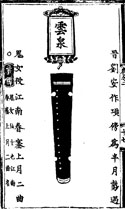
|
35. Gu Ping (Old Bottle) 35-1 ( ⤑ 1539 #35 ) Made by Wang Qin,35-2 when a "cultivated man living in retirement". The area of the two shoulders was scraped away to resemble and upside down bottle. It had a resonant sound. Notes for Image 35 35-1 Old Bottle, Gu Ping 古瓶 3308.xxx [TKW50:] The Zhu volume has "two eyebrows". The other two have "two shoulders", which is correct. (Return) |
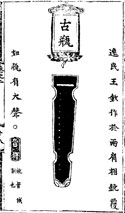
|
36. Zhao Mei (Bright and Beautiful) 36-1 ( ⤑ 1539 #36 ) It is not known who made the Zhaomei qin.36-2
Notes for Image 36
36-2 不知誰氏所作 Compare this Zhao Mei with the one later associated with Mao Minzhong. (Return) |

|
37. Yi Xian (One String;37-1 two extra images: one string qins played by Sun Deng and Taizhenwang Furen) ( ⤑ 1539 #37 ) 師絃為放之樂工。撫一絃琴則地祗皆"田/廾"。孫登字公和,汲 郡人。散髮宛地,行吟樂天。讀《易》,養道。當魏末君白鹿。蘇門 二山。彈一絃琴。 善嘯,每感風雷,嵇康師掌三年不言,王太 真西王母少女彈一絃琴時乘白龍週遊四海也。 音釋:師絃,人姓名。樂工,作樂之人。"田/廾",與也。地祗皆"田/廾",言鬼神皆來听琴也。 宛,轉也;宛地言遍地,宛轉而行也。白鹿、蘇門,二山名。嘯音咲,哦?之聲。太真王母,少女也。w週,適也。 Tentative translation: Shi Xian worked as a musician. When he played his one string qin earthly spirits were drawn in. As for Sun Deng, his style name was Gong He and he was from Jijun (in Henan). With his hair loose he roamed around, humming along and enjoying nature. He read the Yi Jing and cultivated the Dao. Toward the end of the Wei dynasty he (went to?) Bailu and Sumen, two mountains, and the played his one string qin. [Yinshi:] Shi Xian is a man's name. "Official musician" means a musician. "Come out" means "arise". "The spirits would all come out" means the spirits from the lower world would come up to listen to him play the qin. "Wandered" means "roamed about". "Wandered around the land" means to be near to various places and go around to them all. Bailu and Sumen and the names of mountains. "Singing" is onomatapoetic for the sound of singing. Taizhenwang Mu was the name of a woman. "Going about" means "traveling". There is further comment below on Sun Deng, mostly from Qin Shi.) Shi Xian ("Master String")37-2 was an official musician of the Yin (Shang) dynasty. He could play a one-stringed qin (compare #31 above), at which time the spirits would all come out. Sun Deng (image), literary name Gonghe,37-3 was from Jijun. His long hair flowed freely. He wandered around the land and would chant as he walked along. He loved nature, read the Yi Jing, and nurtured his Dao. At the end of the Wei dynasty (220-65) he lived in the two mountains (called) Bailu and Sumen, and played a one-stringed qin. He was a capable singer, (his singing) always bringing on wind and thunder. Xi Kang studied with him for three years, but (Sun) never spoke during this period. Taizhenwang Furen37-4 (image), Daughter of the Ruler of Original Substance Xiwangmu, played a one-stringed qin. She often rode a white dragon while going about traveling through the four seas. Further notes regarding Image 37 (see also Image 31, the one string qin of Maming Sheng)
Lixing Yuanya (1618; QQJC, VIII/333-7) is the only handbook from China's past known to have included tablature for melodies to be played on a one-string qin: it ends with five of them, all with lyrics. The first is relatively long, the others very short. All five seem to have been adapted from the standard qin repertoire, and were quite likely created for this handbook specifically because of the legends mentioned here about a one-string qin.
Most of the Chinese handbooks that illustrate old qin types include at least one one-string qin. The Zhu volume has this qin twice (see QQJC original series, pp. 38 and 42); the images are slightly different from those here, and the latter entry adds the Yin shi, as here. Generally these images don't show the strings, but they can be seen in the image from Deyintang Qinpu (1691) of the one-string qin belonging to Sun Deng, as well as in the images from Liexian Quanzhuan of Sun Deng and Taizhenwang Furen playing a one-string qin (see miniatures at right; the article on Sun Deng has his image in larger size). It is interesting to compare the Chinese one-string qin with the Japanese 一弦琴 ichigenkin. The history of this Japanese one-string zither seems to date back to the 17th century, i.e., around the time of the aforementioned Lixing Yuanya (1618). Lixing Yuanya was published in Nanjing, and it was shortly after this that Jiang Xingchou (Shin-Etsu), who had a connection to Nanjing, brought his qin teaching to Japan. In addition, images (see example) suggest this instrument came to Japan in the same form as in China. However, today the Japanese version looks very different and, even if it did develop from the Chinese one, it is not known to have inherited any Chinese melodies. Instead, as with almost all Japanese instruments, it became completely localized. Its sound and repertoire are rather similar to that of the Japanese samisen. (Return) 37-2 Shi Xian (Master String) 師絃 9129.xxx (Return) 37-3 Under 孫登 Sun Deng, for 字 literary name all versions instead have shou (守 guard) (Return) 37-4 "王太真西王母少女" Wangtaizhen Xiwangmu Shaonü is called 太真王夫人 Taizhenwang Furen in the illustrated Liexian Quanzhuan, which is a later version of Liexian Zhuan; the image at right of Taizhenwang Furen with her one string qin is from Liexian Quanzhuan. Her biography, which is #4 in Folio I, right after that of her mother, Xiwangmu, says her real name was 玉卮 Yu Zhi and that whenever she played her one-string qin 100 birds would fly together, while she liked to fly around on a white dragon. (21296.160/2 玉卮 Yu Zhi says she was the 3rd daughter of Xiwangmu, has nothing on music; 35587.41 Xiwang Mu does not mention Wang Taizhen or music; 5965.302 taizhen has no connection. Xiwang Mu is also mentioned in connection with the text of the melody Qingjing Jing.) (Return) |

|
38. Pi Li (Sound of Thunder) 38-1 ( ⤑ 1539 #38; see also in facsimile) Liu Zihou (Liu Zongyuan) wrote,38-2 The best tong wood grows on the top of rocks. Dried tong trees are even better, better still if the trees are burned. If the fire was caused by lightning, this is best yet. This is what this qin is, both good and special. Put these two together and that's really good. The ordinary people did not know enough to record this. If it weren't for that Daoist, this best (qin) in the world almost went out of existence. So I wrote this essay in praise of him, and wrote this down by the two yue holes, right and left. In order to explain the matter (of this qin),
It was on the bank of the Xiang river,
[Yin shi:] Pili qin was made because a lightning storm burned tong wood which was made into a qin, so it got its name. Lingling is the name of a city. Xiang(shui) is the name of a river. "Remnant of a quaking": thunder knocked it over. Sound hole (yue) sounds like (Emperor) Yu (?); departing tone; it is a hole. "Tumbled down" sounds like kuang (square). "Elevated" is the nickname of a Daoist (i.e., "Daoist Chao"). "Record" (zai) means ________ (unclear). "Almost" sounds like "base" (ji). Notes for Image 38 38-1 霹靂 Pi Li (the sound of thunder) is also the name of a melody, see Pili Yin under Feng Lei. TKW adds the following commentary (note the confusion in QFTGYY of Pi Li with Tan Ge). (Return) |

|
(Four added images
Here QFTGYY copied the four qin styles from the
Taiwan library edition that were not in the Yuan volume. The originals are included here for reference.)
39: QF9. Feng Zui (Phoenix Beak) qf9-1 (Qin Fu, p.43 top right) The name of the person who made this is not known. I would guess Qin Jue (see Feng She) made it. First there was this Feng Zui, and later there was Feng She.qf9-2 qf9-2 [TKW45:] The Yuan volume has no Feng Zui qin; the Zhu volume does, but its explanation says only that it is unknown who made it. The Yuan volume, in its explanation of Feng She, mistakenly says it is unknown who made it. (Return) |

| ||
40: QF23. Lian Zhu (Connected Pearls) (Qin Fu, p.46 bottom right) qf23-1 The retired Sui dynasty scholar Li Yi made this.qf23-2 The side of the jade-woman waist (looks like) connected pearls. Colored strings. When played by day the sound of this qin is clear, like connected pearls. (Mr. Li Yi) wrote Zhuyin Feng, Ai Song Lu, Cao Chongzi qf23-3 and Gui Shan Yue. qf23-4 qf23-2 Li Yi 李疑 14819.xxx; see also Qin Jian (Return) qf23-3 [TKW51:] The Zhu volume correctly has 蟲 chong (for the melody Cao Chongzi) instead of 虫 chong. The Yuan volume does not have this qin. (Return) qf23-4 Two of these are also included in the You Lan list of melodies: Zhuyin Feng and Ai Song Lu. Li Yi is also said to have written 36 short melody-songs. (Return) |
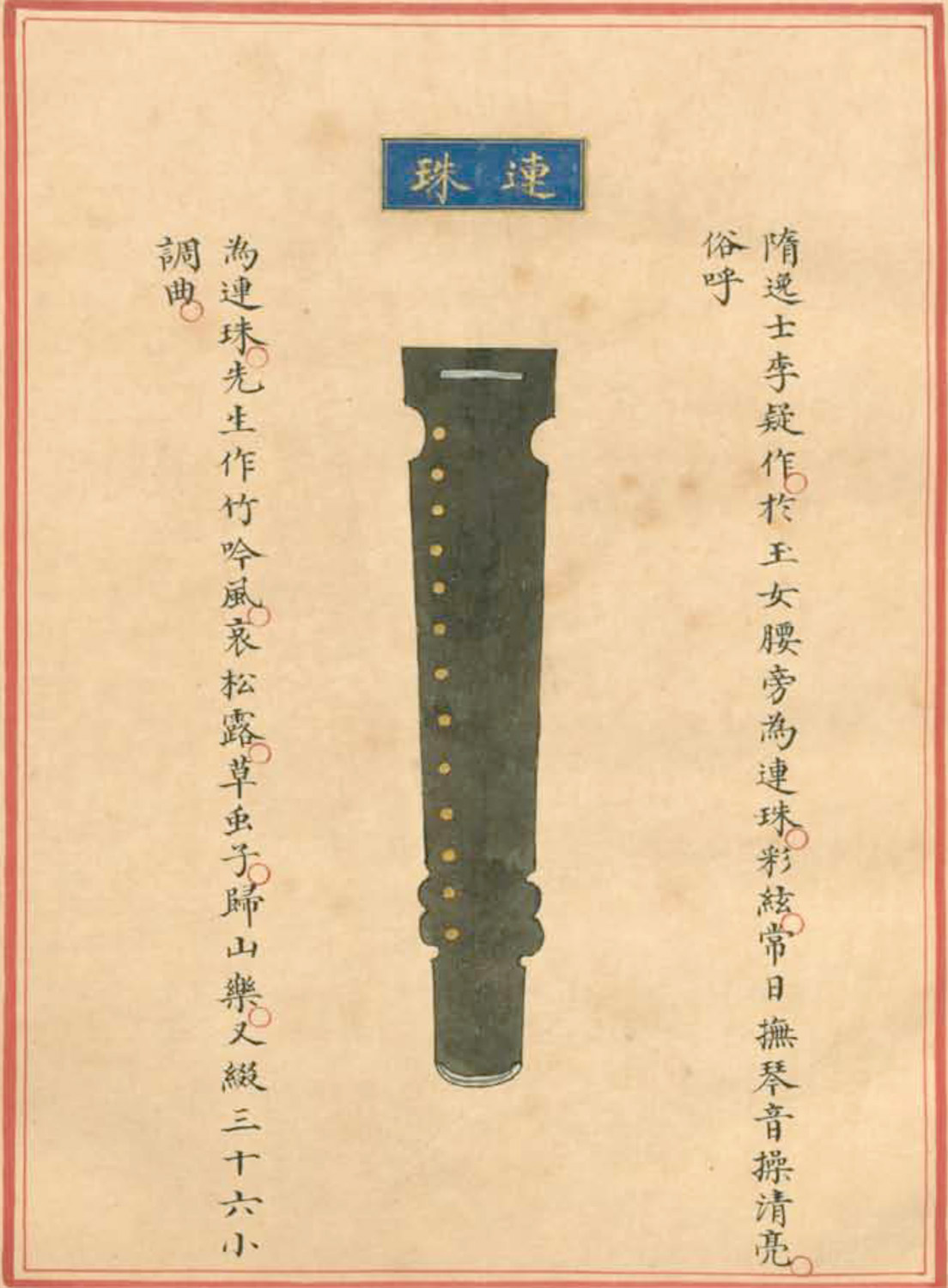
| ||
41: QF#24. Ling Jian (Spirit Shoulders) qf24-1 (Qin Fu, p.46 bottom left) Li Tingfuqf24-2 of the Tang dynasty made it. Below the forehead is a knife shape.qf24-3 The two waists break off. It has a large resonance. qf24-2 Li Tingfu 李廷甫 14819.xx; see also Qin Jian. (Return) qf24-3 於額下制刀形 . Does this mean the image of a knife was carved into the qin? (Return) |

42: QF25/26. Tan Ge (Sandalwood Pavilion) qf26-1 ([Expand:] Here Qin Fu, p.47 bottom, mixes two imagesqf26-2) Pi Chiliqf26-3 made it. On top of the dragon pool its breadth is about 2 cun. During the time of the Tang emperor Xiaozong (r. 756-63) it was given to the imperial palace. Also, it was in the preface (?) to the Ming Jun (= Wang Zhaojun) and Wen Wang tablatures (?).qf26-4
| 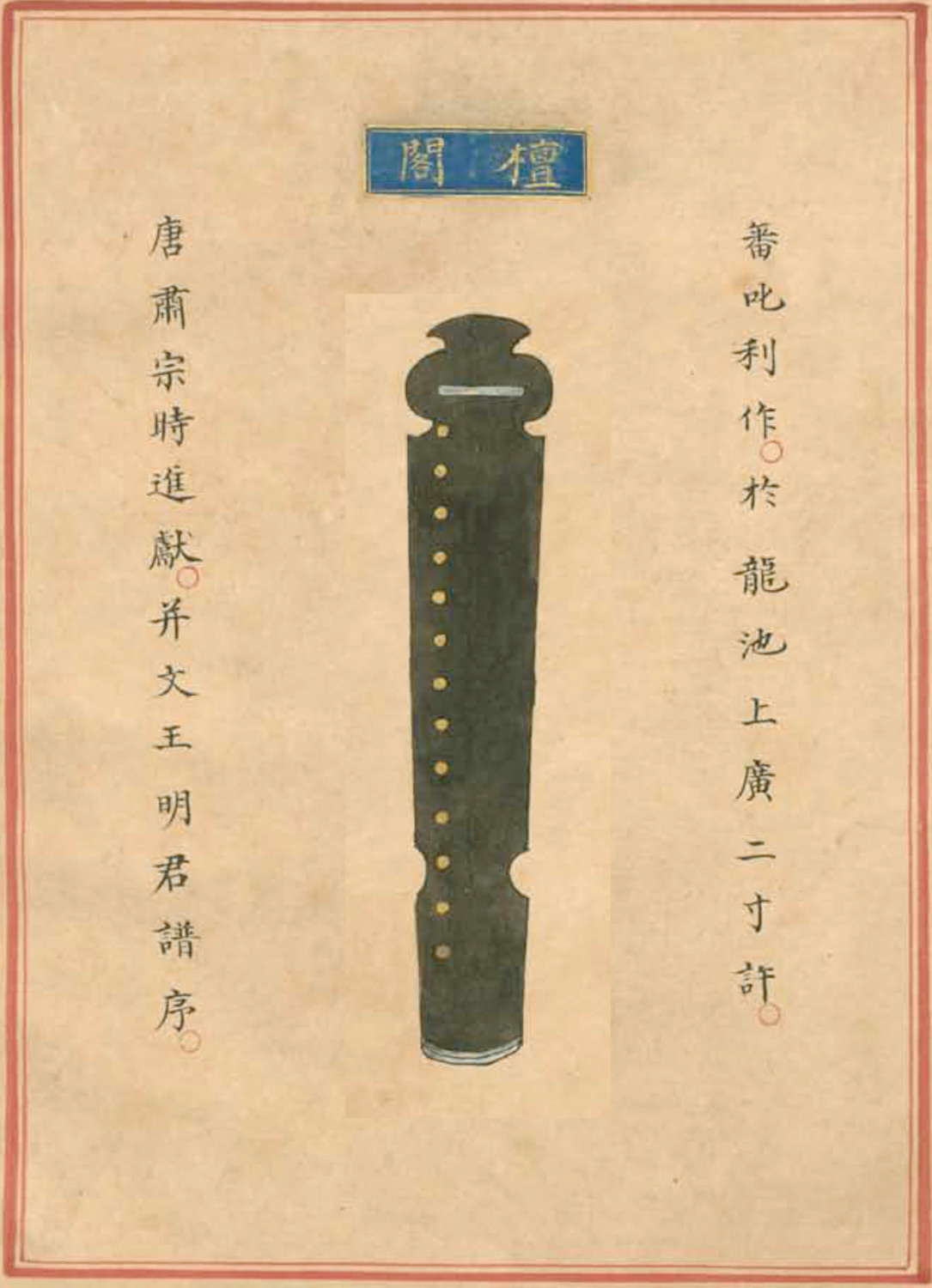
|
| Reversed qins |
|
qf26-2
(The lower image at right [expand] is the original version of the one in QFTGYY.) The left hand image is called Tan Ge while the right hand image is called Pi Li. The commentaries are correct for the attribution, but the images are reversed: the correct image for Tan Ge should be the lower one (but the commentary is correct, as in the corrected image at right). TKW's comment on these two images (see under the Yuan volume's Pi Li) mentions that the Yuan volume (which does not include Tan Ge) uses the upper image for Pi Li, adding that he doesn't know which one is correct. However, other handbooks all have a shape like the upper one for Pi Li (as in
#38 above), so presumably that is the correct one; and the Zhu volume has the lower image for Tan Ge, so presumably that is also the correct one (as at upper right).
(Return) qf26-3 蕃叱利 : Here "Pi" is written "Fan" 番 (22366.xxx) with one extra stroke at top, but elsewhere it is written with the grass radical on top, 蕃, a character usually pronounced "Fan", but 32750 says that as a surname or place name it is pronounced "Pi". The dictionaries have no "Pi Chili". Note that 3328.17 叱利 has Chili as a double surname, so could it be Mr. Chili from Pi? (Return) |

|
Endnotes (Shorthand references are explained on a
separate page)
1.
Source of this page
The original of this passage is in the Taiyin Daquanji reprinted in QQJC Vol. I, pp. 42 - 51 (30 Volume edition pp. 52-61). The translation is here modified from the rough one I made in the 1970s of the similar passage as reprinted in QFTGYY, pp. 41 - 54. In that version pp. 41 - 46 and the bottom of 47 have the 26 qins TKW hand-copied from the original Yuan volume; at the top of 47 is an explanation by TKW plus the first of the 20 qin images he added from the Taiyin Daquanji edition. This makes 46 images in all in QF, but it has 2 versions of four and a further four (#39-42 here) were in the Yuan edition but not in TYDQJ. It should be noted that the order between the two versions is different, and also that the meanings of a number of passages still elude me.
(Return)
2.
琴式 Qin shi ("Qin Styles") (as found in
handbooks such as these)
The "式 shi" of "琴式 qin shi" can have many translations, thus
qin styles, qin shapes, qin types, qin templates, qin models, qin shapes and so forth. Here I have reserved "qin types" (or "qin-types") to refer to the instruments such as those shown here, excavated from the Chu region. One might arguably use "qin types" for the 1-string, 5-string and 9-string versions, as they might best be served by instruments of quite different proportions, but in reality the appearance of those instruments was not distinguishable from that of the standard 7-string instruments.
(Return)
3.
Explanation
See the comments concerning the structure of the original text. Note also that in addition to these endnotes the present page has footnotes within the introduction to the qins themselves. Note also that with some of the qin styles it is not just the shape of the qin that is important but also the decoration. Since the images in the original were not always printed clearlyl, TKW in his Qin Fu tried to fix this by filling in the outlines in accordance with the clearer images he could find in later handbooks. This is also done here.
Several of the qins described here are also mentioned in
Qinshi Bu (this includes numbers 28, 33, 34 and QFTGYY #24), usually quoting Guangbowu Zhi. Another source of information is Qin Jian
(or Qinjian Tushi?; this includes numbers 31 and QFTGYY 26).
(Return)
4.
A comment on the different editions
Folio 2 of this edition (the Yuan volume"), in addition to the 38 illustrations of famous (or legendary) qins, has comments on a further 15 "qins without illustration", as well as a discussion of qin types and qin appreciation.
Xinkan Taiyin Daquanji (the "Zhu volume") has mostly the same illustrations and commentary, but in a different order, renaming one (#14) and adding none. It includes the four illustrations that are in QFTGYY but not in the Yuan volume (QF 9, 23, 24 and 25 or 26), misses three of the illustrations (#s 2, 3 and 27), repeats one image (#37) and several commentaries (the first five in part 2), and mixes together the qins without illustrations with those that have them.
Below TKW explains his re-arrangement of the the order of the qins in QFTGYY. QF also has four illustrations that were not the Yuan volume but are in the Zhu volume (see above): in QF (where they are not numbered) they are in sequence its #s 9, 23, 24 and 26; they are added as the last four images at the end of this webpage. Originally QFTGYY had altogether only 26 illustrations, so TKW added to this 20 from the Yuan volume. However, since four of these were already included in QFTGYY, the 46 images in Qin Fu actually represent 42 different qin styles (26 + 20 - 4 = 42). It should also be noted that some qins with different names have small differences in appearance, and one is completely different: the 25th of the original images in QFTGYY, called Pi Li, does not look at all like what the Yuan volume calls Pi Li (see its #38). Instead it is the 26th QFTGYY image, here called 檀閣 Tan Ge, that looks like the Yuan edition's Pi Li.
QFTGYY also adds at the end of this section (see Qin Fu, p. 54) a 彈琴歌 Song of Playing the Qin and a 聽琴行 Ballad of Listening to the Qin. Here these are included in Part 2.
The four qin images in QFTGYY not included in TYDQJ (the number indicates the order in QFTGYY) are introduced after the 38 TYDQJ images as #s 39 - 42.
5.
Traditional qin handbooks that include images of
"qin styles"
Images shown on this page represent the earliest known depictions of "historical" qin styles. Such depictions then continue with those listed here.
Most have only images of the qins themselves, but 1539 adds images of people playing, carrying or holding them (these are each linked with their related image, starting with #1 above) The 1539 handbook itself lists them
here.
After the present version with its 38 qin images, the later handbooks with them have mostly the same qin images and connect them to the same people, though often adding some or removing others. Note also that such images occur in only two handbooks after 1722. Most of these also have fingering gesture diagrams plus poetic representational images, as indicated below (starting here):
Handbooks with images of "historical" qin styles:
There is some further detail on this in Yang Yuanzheng,
Dragon's Roar, Appendix I.
Beyond what can usually be found in the traditional handbooks, see also:
(Return)
6.
Illustrations in 風宣玄品 Feng Xuan Xuan Pin
There is no information about the source of these illustrations, which are presumably later than the "Song Dynasty" illustrations described next.
(Return)
7.
宋人畫歷代琴式圖 Song dynasty drawings of Historical Qin Styles
These images, apparently of uncertain date and not included in any qin handbooks, show up as sepia illustrations in the digital catalogue of the 國立故宮博物院 National Palace Museum, Taiwan. The Museum publication 故宮書畫圖錄, 22册, the Record of Illustrations in the National Palace, Volume 22 (2003), pp.102-111, has 31 small black and white images, presumably the complete set, also transcribing the text written at the top of each image (see .pdf). The article says little about the source, writing at the end only that they were "鑒藏寶璽 三璽全。嘉慶御覽之寶。宣統御覽之寶。樂壽堂圖書記。重三十", i.e., in the imperial collections of the Jiaqing (1796-1820) and Xuantong (1909-1911) emperors at their Enjoy Long Life Hall Book Collection (at Yihe Yuan Palace): perhaps copies of an earlier work?
The 31 宋人畫歷代琴式圖 Song dynasty drawings of Historical Qin Styles are as follows, with links to all the images but not yet to the related commentary:
- 盤古氏 Master Pangu (image but no qin or mention of it - only image like this)
- 宓羲之制 Fu Xi style (Fu Xi)
- 女媧琴式 Nü Wa style (Nü Wa)
- 神農之制 Shen Nong style (Shen Nong, image)
- 黃帝之製 Yellow Emperor style: Di Zhong (Yellow Emperor; image)
- 堯帝琴式 Yao Di qin style (Emperor Yao)
- 帝舜之琴 Emperor Shun's qin (Emperor Shun; image)
- 夏禹之製 Xia Yu style (Da Yu)
- 成湯之製 Cheng Tang (image)
- 文王之製 Wen Wang style (Wen Wang; 文王之製)
- 武王之製 Wu Wang (image)
- 周公之製 Zhou Gong style (? He played Ling Guan; Zhou Gong)
- 老聃之製 (Laozi (老子, image)
- 孔子之製 Confucius' style (Confucius; 孔子之製)
- 列子之製 Liezi (image)
- 閔子之製 Minzi (image)
- 伯牙之琴 Boya (image)
- 月琴之式 Yue Qin (moon style image)
- 龍腰琴式 Dragon Waist style (Xie Juanzi)
- 龍額之製 Dragon forehead style, compare Dragon's Jaws (image)
- 雙月琴式 Double Moon style (Rong Qiqi)
- 趙合之製 Zhao He style (image; commentary tells of Zhao He meeting an exemplary woman (烈女) who had created a Lament called Returning Phoenix (歸鳳之操 Gui Feng zhi Cao)
- 革子之式 Gezi style (Qishi Gezi)
- 相如之製 (Sima) Xiangru (image)
- 伯偕之製 Boxie style (name of Cai Yong; image)
- 雲泉之琴 Yun Quan (Cloud Spring) Qin (of Liu An; image)
- 此製有三 Three kinds (Xiao You; 此製有三:雲和、空桑、龍門)
- 正合之琴 Zheng He (Correct Mixture) Qin (of Southern Song emperor Wendi during 424-454; comment; image)
- 連珠琴式 String of Pearls qin style (Li Yi)
- 檀閣之製 Sandalwood Pavilion (Tan Ge; comment; image)
- 霹靂之琴 Sound of Thunder (Liu Zongyuan; 霹靂之琴)
See other lists above.
(Return)
Return to Taiyin Daquanji
